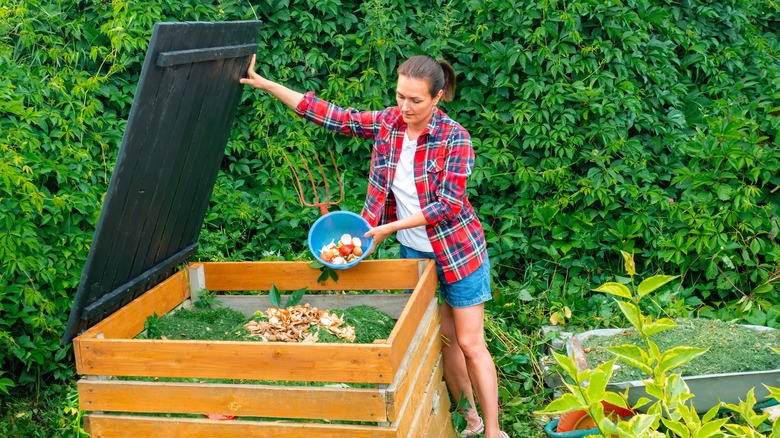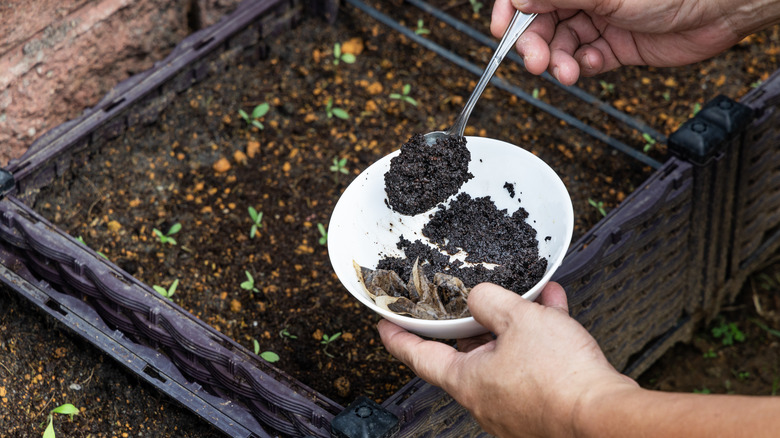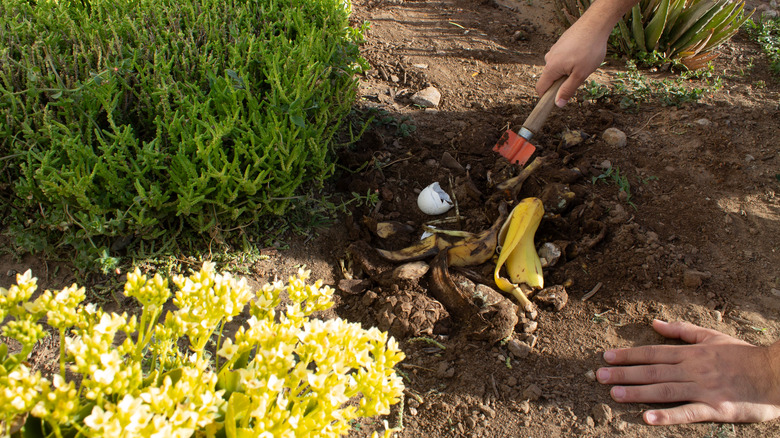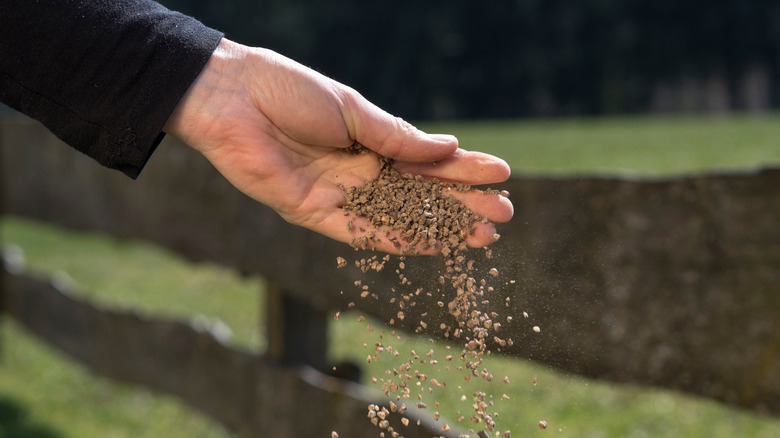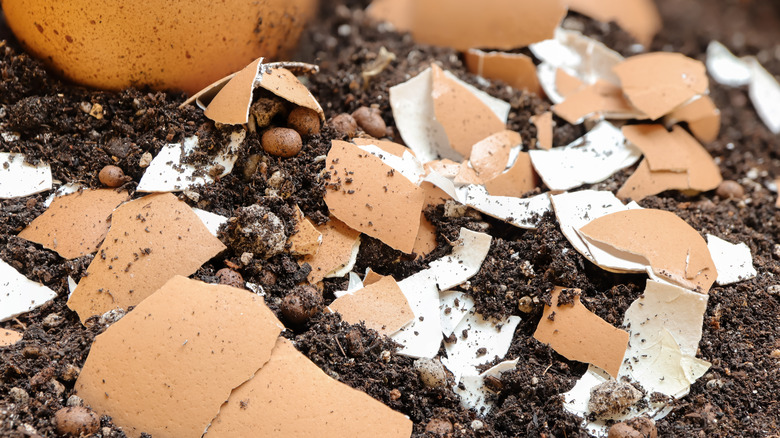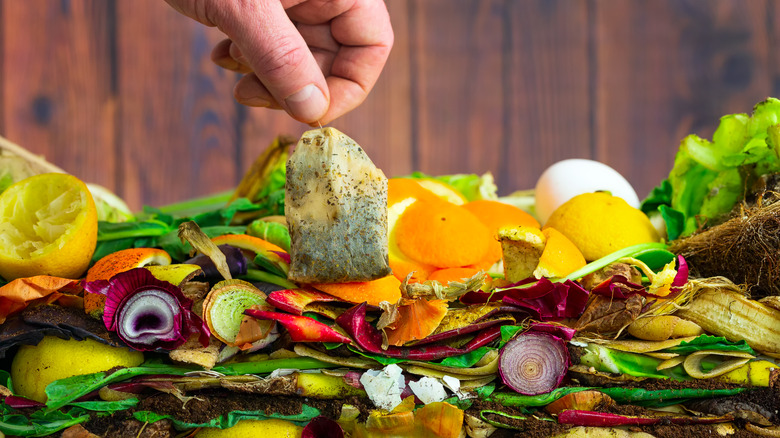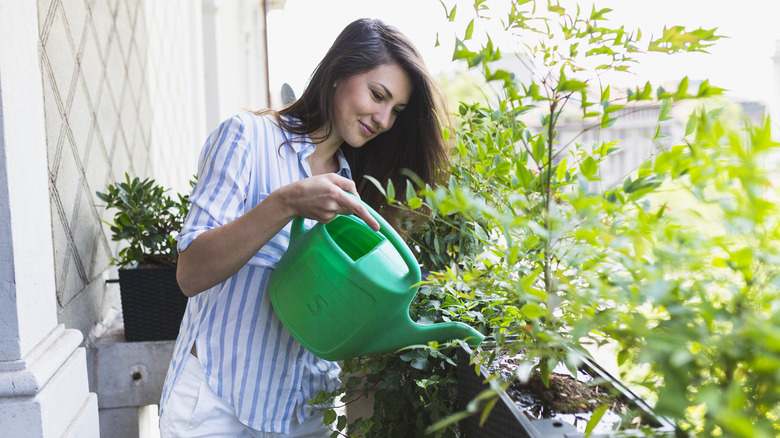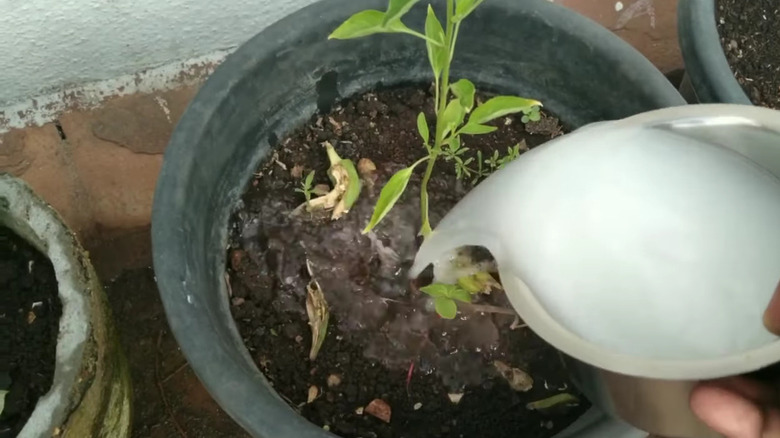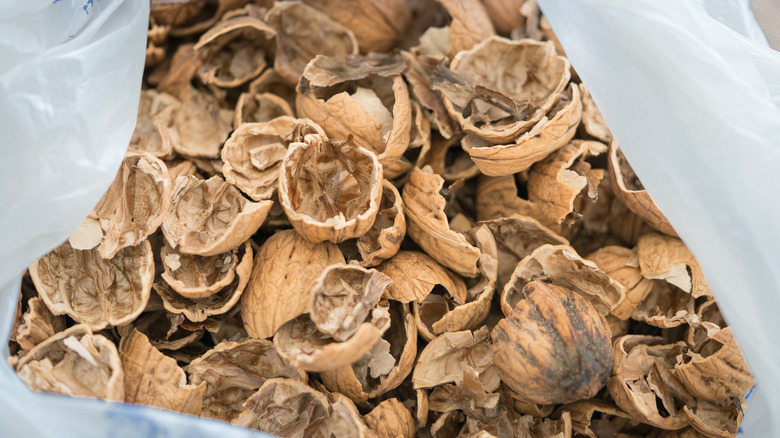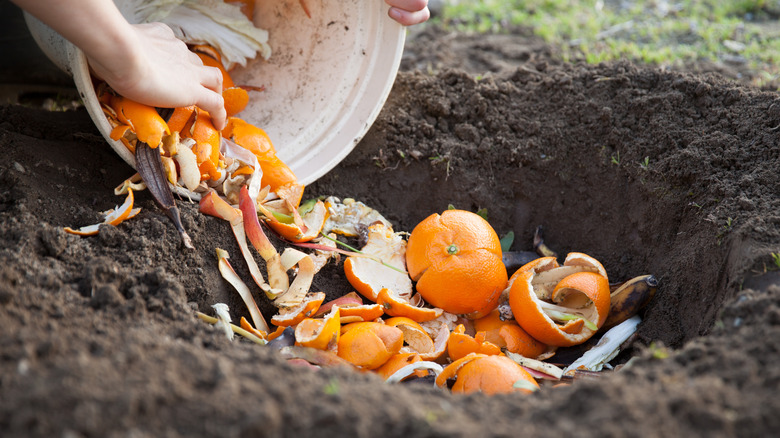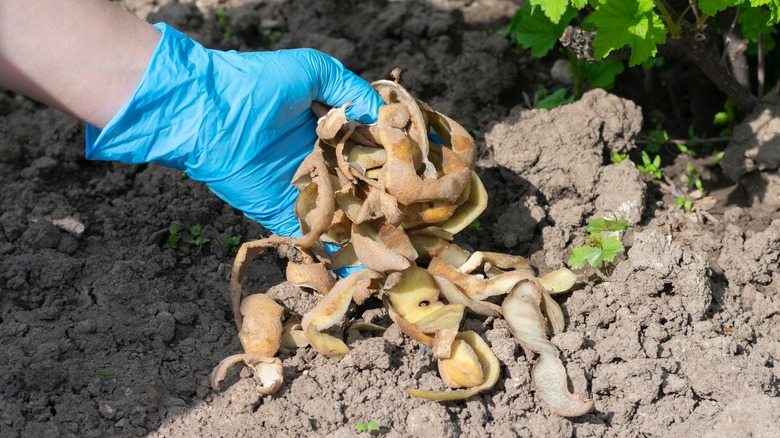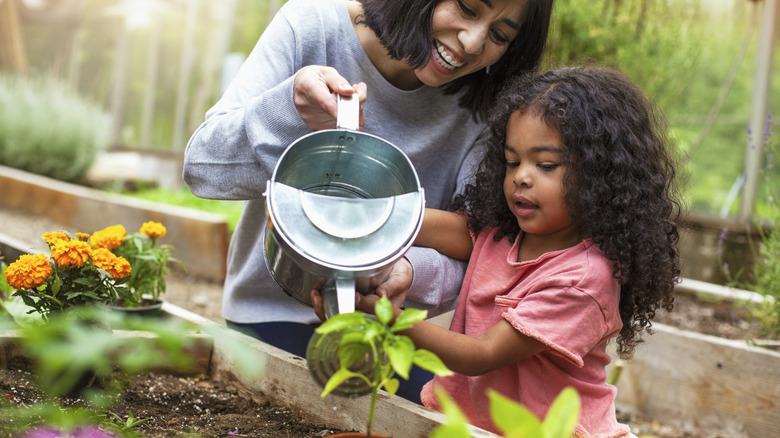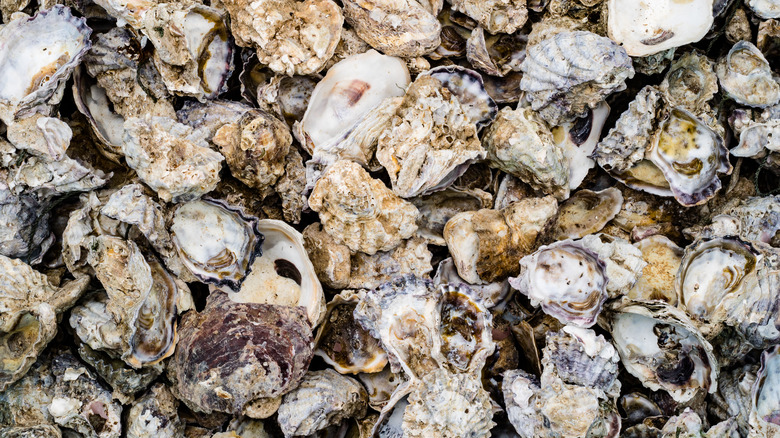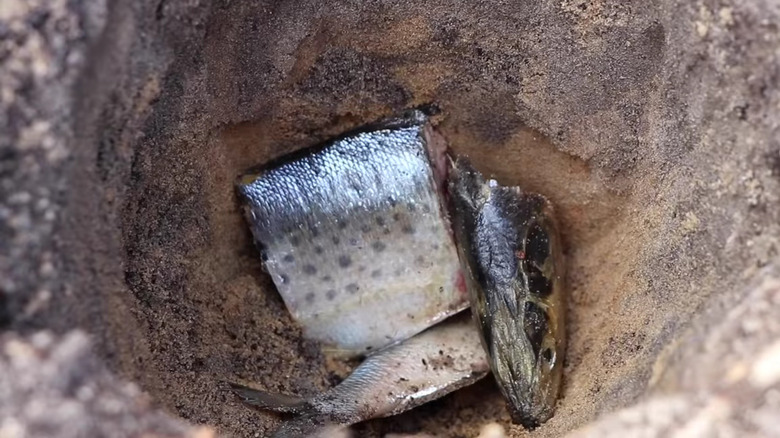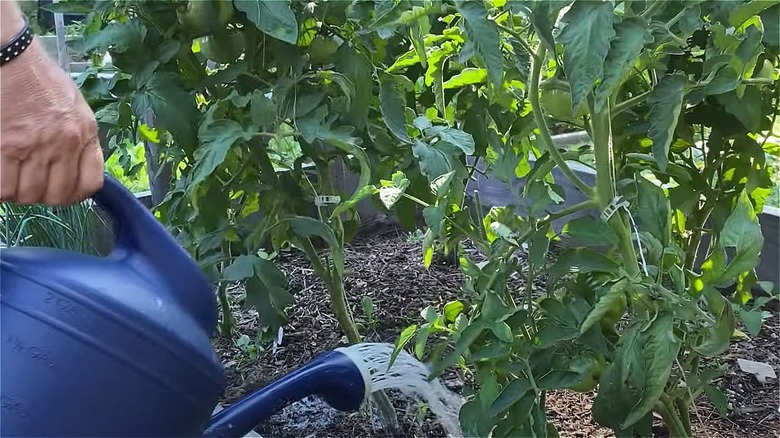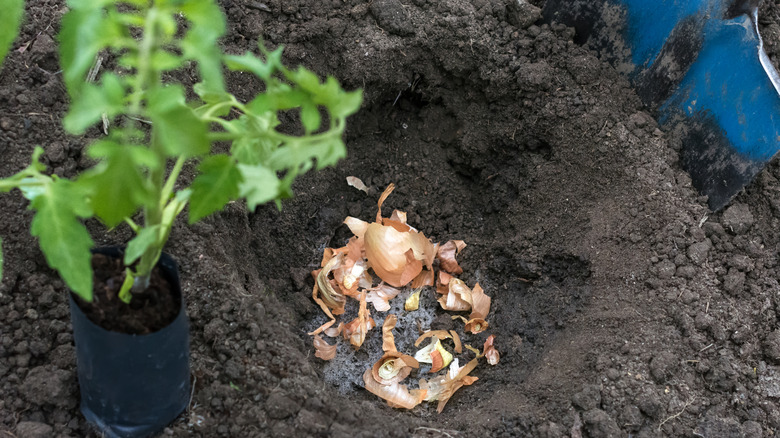16 Food Scraps That Can Be Used To Fertilize Your Garden
While we often love the taste of food and need it to survive, we also dump billions of dollars worth of food into the trash annually. In fact, it's estimated that, in the U.S., waste that could add up to 68 million meals is being thrown away each year. That's a lot of wholesome goodness that could be redirected, recycled, and reused as fertilizers in our gardens. Fertilizers come in all shapes and forms, but their sole purpose is to provide plants with the chemical elements they need to survive and thrive.
Although synthetic fertilizers contain the same nutrients as natural types, their quick-fix formula means they provide less nourishment for your soil, whereas organic fertilizers act slower and are the gift that keeps on giving. In the average household, there's a whole host of food scraps that end up in the waste bin. A lot of these could be used to make your garden a healthier, happier, more organic, and more productive place. So the next time you peel that banana, chop that onion, crack those eggs, or boil those vegetables, stop and consider how beneficial the waste product could be for your soil. Not only could you help save the planet, but you could also save yourself a few bucks. You'd also be surprised how effective food scraps can be as a fertilizer in your garden.
1. Wake up and smell the coffee
There's nothing quite like the aroma of some freshly-made coffee to lift your spirits and kickstart your day. However, when the caffeine wake-up call has done its job, don't ditch those coffee grounds because they can be quite beneficial to your plants. Coffee grounds contain substantial quantities of nitrogen, potassium, and phosphorus, which makes them ideal as slow-release fertilizers. Use the leftover coffee grounds as fertilizer by sprinkling them over your soil before gently raking them in. As an organic material, the coffee compost will help the soil retain water and boost its drainage and aeration properties.
Because coffee grounds lower the pH level of the soil, they work best on plants such as roses, hydrangeas, and hollies that thrive in more acidic conditions. However, it's wise to keep them away from tomatoes and rhododendrons because their tips may turn brown when they come into contact. Also, keep freshly-seeded areas clear of this natural fertilizer because it could interfere with the process of germination. Because coffee grounds are abrasive, they're also great at repelling slugs and snails. If you have any leftover coffee, you could mix 2 cups of it with 5 gallons of water, leave it overnight, and presto! You have a liquid plant fertilizer.
2. Go bananas!
Bananas are loaded with potassium, magnesium, vitamin B6, vitamin C, and a potent assortment of antioxidants. Yet it's not just your body that can benefit from the properties of this super fruit. When you've had your fill of its flavor, you can throw the inedible banana peels on an existing compost pile, plant them in some soil, or ferment them in a little water to create a spray fertilizer. The potassium, calcium, magnesium, and phosphorus in banana peels can improve nutrient distribution in your plants, improve root growth, and strengthen the stems.
To make a fertilizer slurry, soak your banana peels in some water before blending them in a food processor. Then dig a shallow hole to place the slurry near your plants. To make a spray fertilizer that is rich in nutrients and great at repelling bugs, soak the peels in water for seven days or more, depending on how acidic you want the fertilizer to be. Once you remove the peels, you'll have a liquid fertilizer to spray at the base of your plants. Finally, to deter pests from your garden, you can slice the banana peel into tiny pieces and bury them around the plants you wish to protect.
3. Brittle bones can benefit your plants
People have been using bone meal fertilizer to help things grow for generations. Many people still buy it from the store, but after realizing how easy and inexpensive it is to make at home, you're guaranteed to get busy baking. There's something timelessly rewarding about using the bones left over from a chicken dinner to help make your garden grow. Bone meal's secret ingredient is phosphorus, which is the key to quality soil. It's also rich in calcium, which is great for tomatoes and peppers. The results of this slow-release fertilizer speak for themselves, particularly with flowering plants such as roses.
To prepare bone meal, ensure your bones have been picked clean of all traces of meat and fat. Then, if possible, pressure cook them for five minutes. Next, place them in an oven and bake at 425 degrees until they're brittle and dry, or for about 1 hour. Let them cool, place them in a bag, and then beat them with a rolling pin until they are crushed into tiny shards. Finally, blend them into a powdery substance, and you're good to go. Bone meal fertilizer works best when you use 10 pounds for every 100 feet of soil. To prevent pests from eating it, ensure you mix it thoroughly with the soil as opposed to just scattering it on the surface. For transplants, 1 tablespoon for each planting hole is ideal.
4. You can't make a fertilizer without breaking a few eggs
Next time you make an omelet, hold onto those eggshells because they make a cracking fertilizer. The shells are rich in calcium carbonate, potassium, phosphorus, and magnesium, and all of these nutrients are great for your garden. Eggshells boost the alkaline levels of the soil and lower its pH levels, so it is a great choice of fertilizer for plants that thrive in less acidic soil. The smell of the eggshells can help deter deer, and their sharp edges could rid your garden of snails and slugs.
A plant's roots will benefit from the calcium carbonate found in eggshells. Strawberries, apples, lettuce, and cucumbers are just a few of the fruit-bearing plants that benefit from these natural fertilizers. However, avoid using them on beans, spinach, and cabbage. They can also cause disease in other plants that thrive in acidic conditions such as violets, azaleas, and geraniums. To prepare an eggshell fertilizer, wash and dry the shells before crushing them into a powder with a rolling pin, then sprinkle them around your plants. Along with placing eggshell pieces in your garden, you can also mix them into your flowerbed or place them in the potting mix for your indoor plants.
5. Time for tea
When things are tense and you need to unwind, a cup of tea is just the tonic. After you've let the soothing herbs calm your mind and restore your senses, why not take the soggy and forlorn-looking tea bag and use it to fertilize your garden? In tea leaves, you'll find natural fertilizers such as tannic acid. As the tea bag breaks down, all those nutrients are absorbed by the soil, helping the plants grow. Seedlings love used tea bags, and they are a perfect food source for earthworms who fertilize the soil. The smell of tea bags can also help deter bugs, spiders, and mice.
Bury your tea bags in the soil to use as a natural fertilizer in your garden. Alternatively, you can simply brew them again and use the weakened brew as a liquid fertilizer on your potted plants. One reason many gardeners use tea bags in the garden is that they can help control weeds. Additionally, if you are worried about fungus growth on any of your plants, brew up a weak cup of chamomile or black tea, then use it as a spray to keep the rot at bay.
6. Pasta water is boiling over with some nutrient goodness
Who doesn't like a bit of pasta? It's versatile, goes well with a host of dishes, and is a walk in the park to cook. Next time you've finished cooking up your spaghetti, fettuccine, or macaroni, think twice before you ditch the cooking water down the drain. Provided that there's no added salt or seasoning in it, the water you cook your pasta in can be used as a low-grade fertilizer for your garden. If there's any salt, this could dehydrate your plants and lead to further complications, so make sure the water is clean.
Pasta water is nowhere as strong or effective as a lot of the other food scrap fertilizers on this list. However, it's a great way to cut down on water use whilst adding some much-needed nutrients to your garden. Plants love starch because it gives them energy, and your leftover pasta water is full of it. The water may also contain iron and calcium, two minerals that are very beneficial for your plants. You may want to pair this fertilizer with another natural type on this list to ensure your plants are getting enough nutrients.
7. Rice water is just the tonic
Like pasta, rice is a basic food staple and one of the most popular carbohydrates in the world. The water you boil rice in can also be used as a handy fertilizer, as the starch in the water is utilized in a number of ways by plants. Rice water can assist in cultivating friendly bacterias like lactobacilli and mycorrhizal fungus, which can strengthen the plant's roots and help them combat disease. The plants can also store carbohydrates from the rice water in their cells as a source of energy.
Rice has low-level traces of nitrogen, phosphorus, and potassium, which are essential to plant life. Boiled rice water also contains magnesium, zinc, and vitamins B, C, and E. These can help strengthen a plant's stem, protect photosynthetic tissues, and create a healthier-looking plant. Using rice water is environmentally friendly and cost-effective. However, in abundance, the carbohydrates can attract pests like ants, overwhelm plants, encourage bad bacteria, and harden the soil. Therefore, it is recommended to use a small amount only every two to three weeks. To use, simply wait for the water to cool and apply to the soil.
8. The answer in a nutshell
The best thing about a walnut is its taste and texture. The worst is its unsightly and irksome shell. Yet, the next time you crack into one of these nutty delights, instead of throwing the damaged and unwanted shell straight into the trash, think twice and recycle it as a garden fertilizer. The shell of a walnut contains phosphorus, potassium, sodium, iron, and zinc and small amounts of manganese, calcium, magnesium, and copper. Walnut shells can make your soil more fertile, and their abrasive texture can improve the aeration of your soil. They are also great at preventing weeds and keeping moisture locked in the soil.
Walnut shells also contain amino acids, steroids, alkaloids and tannins that can help your plants fight detrimental microorganisms and repair any tissues that have been damaged. As they decompose, all this goodness will slowly be released. You can spread the shells in an even layer on your soil, but don't place them more than 2 inches deep. As they rot, the soil and the roots of the plants will absorb all the nourishing nutrients. Walnut shells are slow-release fertilizers, so it will take time to notice their effect. If you want to speed up the process, it's advised to grind the walnut shells into a powder form as opposed to letting nature do its work.
9. Get fruity
We know that banana peels are a heaven-sent garden fertilizer, but the skins of other fruits are also loaded with the sort of goodness that money just cannot buy. If you want to get ahead of the game as a gardener, don't throw away your fruit peels, but recycle them as a fertilizer instead. Orange peels are brimming with zinc, calcium, nitrate, iron, and potash and contain high nitrogen levels. For best results, mix four to six peels with 100 to 200 milliliters of water to create a paste. Dilute it with more water and use it once every six to eight weeks. The potassium, iron, phosphorous, calcium, copper, and zinc found in the peel of pomegranate also makes for a good fertilizer and can be prepared in much the same way as orange peels.
Mango peels have a reputation for encouraging growth, and the vitamins A, C, and B6 and copper, folate, and dietary fiber work wonders on gardens. For best results, slice it into small pieces, put the pieces in an air-sealed container with 1 cup of water, and leave them for a day. Then, stir the peels, and let them sit for another day or two. Next, place the solution in a blender, mix it with a little water to dilute it, and use it every month or so. Other fruit peels that also make for good garden fertilizers include those from lemons, grapefruits, apples, and papayas.
10. Recycle your greens
It's not just fruit peels that contain the sort of nutrients our gardens cannot get enough of, as vegetable peels are also brimming with fertilizing superpowers. Fertilizer made from vegetable peels is rich in the usual suspects of nitrogen, potassium, and phosphorous and will shower your plants with micronutrients. For the best results, gather all your potato and carrot peelings and any other vegetables you have recently sheared and place them in a container. Next, cover them with water, and let them sit for 24 hours. Pour the water through a sieve, and the resulting concoction will make a fine liquid fertilizer for your plants.
Alternatively, you can boil the vegetable peels to speed up the process. Although boiled vegetable peels are not as mineral dense, they can still be reused. If you wish to use the planting method and allow your raw or cooked vegetable peels to act as a slow-release fertilizer, dig a hole with a depth of about 8 to 12 inches and fill it with peels before covering it with soil. Remember to use small peels if you want them to decompose quickly.
11. Reuse your vegetable water
After boiling broccoli, carrots, or peas, we tend to throw the water down the sink without a second thought. In times gone by, many people used to drink the water we prepared our vegetables in for trace nutrients, and some chefs still repurpose it to prepare other dishes. If none of these reuses appeal to you, how about using it as a fertilizer? Vegetable water is rich in nitrogen, calcium, and iron, and provided it has no added salt, your plants will thank you for it.
Once the water has cooled, you can simply pour it over your garden or use it as a spray fertilizer. Provided that it contains no salt, you can use vegetable water in your garden weekly. The calcium will help your plants produce cells, the nitrogen will help them grow and avoid malnourishment, and the iron can assist in chlorophyll formation, which is essential for photosynthesis. All in all, vegetable water is just the tonic for your garden.
12. The world is your oyster
If, in these austere times, you find yourself feasting on a platter of oysters instead of a bag of economy burgers, don't ditch the shells. The remnants of your seafood dish can double up as an effective garden fertilizer. Oyster shells are filled with calcium carbonate. If you don't dine on oysters all that regularly but live near a beach, even better. Take a stroll along the sands and see how many you can collect yourself. You could also try getting in touch with your nearest seafood restaurant to see if they'll save some shells from the trash can for you.
Oyster shells can help with the balance of pH levels in your soil. They also help fortify the cell walls of your plants and assist in the formation of enzymes. To use oyster shells as a garden fertilizer, you need to ensure they have been washed completely clean of salt. Once they're clean, cover the shells with a towel and smash them into tiny pieces using a hammer. It's recommended that every 100 square feet of garden should have 6 pounds of crushed oyster shell. Make sure you water the surface thoroughly after covering it with oyster shells so that the pieces don't blow away in the wind.
13. Something smells fishy
Ever purchased a whole salmon and been at a loss for what to do with the head and tail? Well, wonder no more, because fish remains and leftovers make for an excellent fertilizer. Fish has plenty of trace minerals and many nutrients, particularly nitrogen, and it has been used as a fertilizer since ancient times. However, you should always use fish scraps sparingly because their pungent smell can cause neighborly disputes. Additionally, many fish contain pathogens and parasites that could contaminate the soil. Due to the increase in polluted oceans and lakes, many fish are also riddled with heavy metals such as mercury, which can poison the soil. The smell of rotting fish may also be attractive to pests.
If none of the above has dissuaded you and you believe your garden could benefit from a dead fish or two, here's what to do. Dig a trench at least 12 inches deep and bury the fish scraps. A fish head often produces striking results in nearby plants. Yet be warned, don't bury fish scraps near plants you eat whole such as carrots. Fruit-bearing plants such as tomatoes are your best bet because any pathogens are very unlikely to contaminate the produce. You can also blend the fish scraps with water and use them as a spreading fertilizer. However, this method is far less popular because of the stench.
14. The wonder of wine
A world without wine would be a very dry and dismal place. It may be painful to contemplate wasting any rare vintages on your plants. However, if you have a small amount left of the bog-standard stuff remaining, why not let your garden have a little taste of the exotic grape juice? Since the 17th century, gardeners have been using the tannins in wine to combat plant diseases. Yet pouring a bottle of red directly over your garden won't just hurt your finances; it'll probably kill your plants. The trick is to take any leftover red wine (not white) and let it ferment into vinegar. By allowing the wine to spoil, you're releasing the nitrogen, which encourages plant growth.
Once the wine is no longer fit to be served with a tender piece of fillet steak, it's time to add it to your compost. Only add a small amount and don't include it too frequently, because a large amount of wine may upset the balance of the fertilizer. Once the nitrogen in the wine has activated the good bacteria, the compost is now ready to apply to your garden. Another great use for wine gone bad is as a herbicide, since it can be used to stop root growth.
15. Don't cry over spilled milk
Milk is the stuff of life for plants as well as mammals. Combined with its antifungal and pesticidal qualities, milk also makes for a great fertilizer. Full of calcium, this liquid encourages plant growth and can prevent calcium-deficient diseases such as blossom end rot, which is prevalent in tomatoes and peppers. As an antifungal agent, milk can also help combat powdery mildew, a fungal condition that blights various plants. However, in large doses, milk in the garden can damage your plants. Milk's bacteria can also stunt growth, cause plants to rot, and leave an unmistakable stench. Moderation and due care are key.
Fresh, spoiled, or evaporated milk could be used as a fertilizer, as long as it's diluted beforehand. Reduced fat or low fat is better than skim or whole types. Mix the milk with an equal amount of water and spray it over the garden. A 20-by-20-foot garden will require 1 quart of milk. Once this natural fertilizer has been applied, don't use any chemical pesticides or other fertilizers, as this would kill the milk's good bacteria. You can also apply this fertilizer directly onto the leaves of your plants. After 30 minutes, if there are any traces that haven't been absorbed, remove them with a damp cloth.
16. The hidden layers of an onion
There's much more to an onion than meets the eye. The sharp-tasting and sharper-smelling vegetable has unfathomable uses, and one of them is as a fertilizer for your plants. Onion skins and peels are abundant in antioxidant and antimicrobial qualities and also contain iodine, iron, zinc, potassium, and phosphorus. The carotene in onion can help a plant stay disease-free, while the vitamin B can boost the roots and stems of your plants. Further, the vitamin PP can speed up the process whereby nitrogen becomes oxygen and encourage more growth.
You can use dry onion skins as mulch, as the decomposing scraps will provide your soil with some much need potassium and calcium. To make an onion fertilizer, soak the leftover onion peel in 1 liter of water for 24 hours. Many dispute the merits of boiling onion scraps before using them as a fertilizer, so it's best to use lukewarm or cold water. Once you have strained the resultant liquid, you have a handy supply of onion fertilizer to add a bit of flavor to your soil. As with everything else on this list, use wisely and you'll soon notice a difference in your garden.
